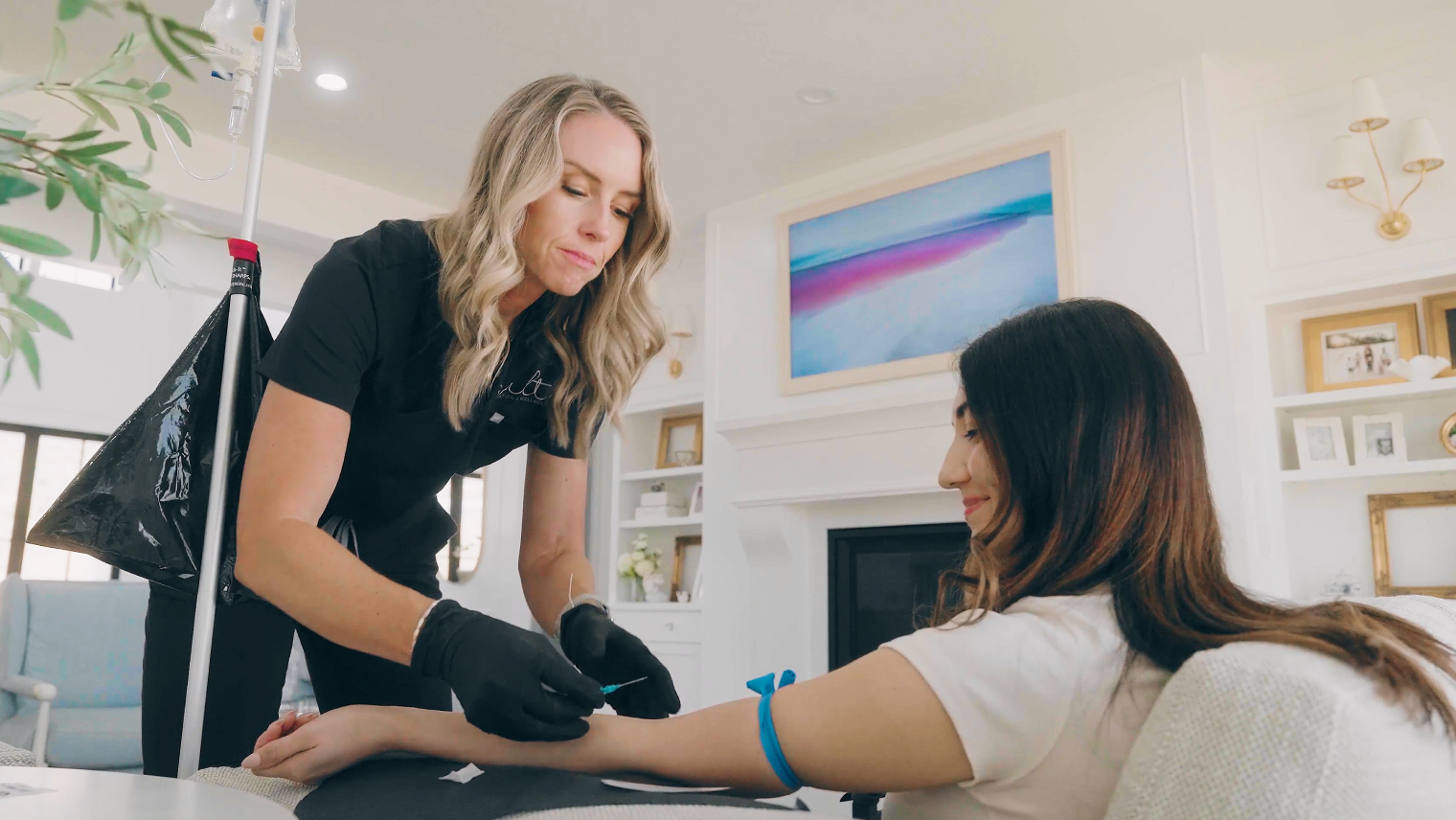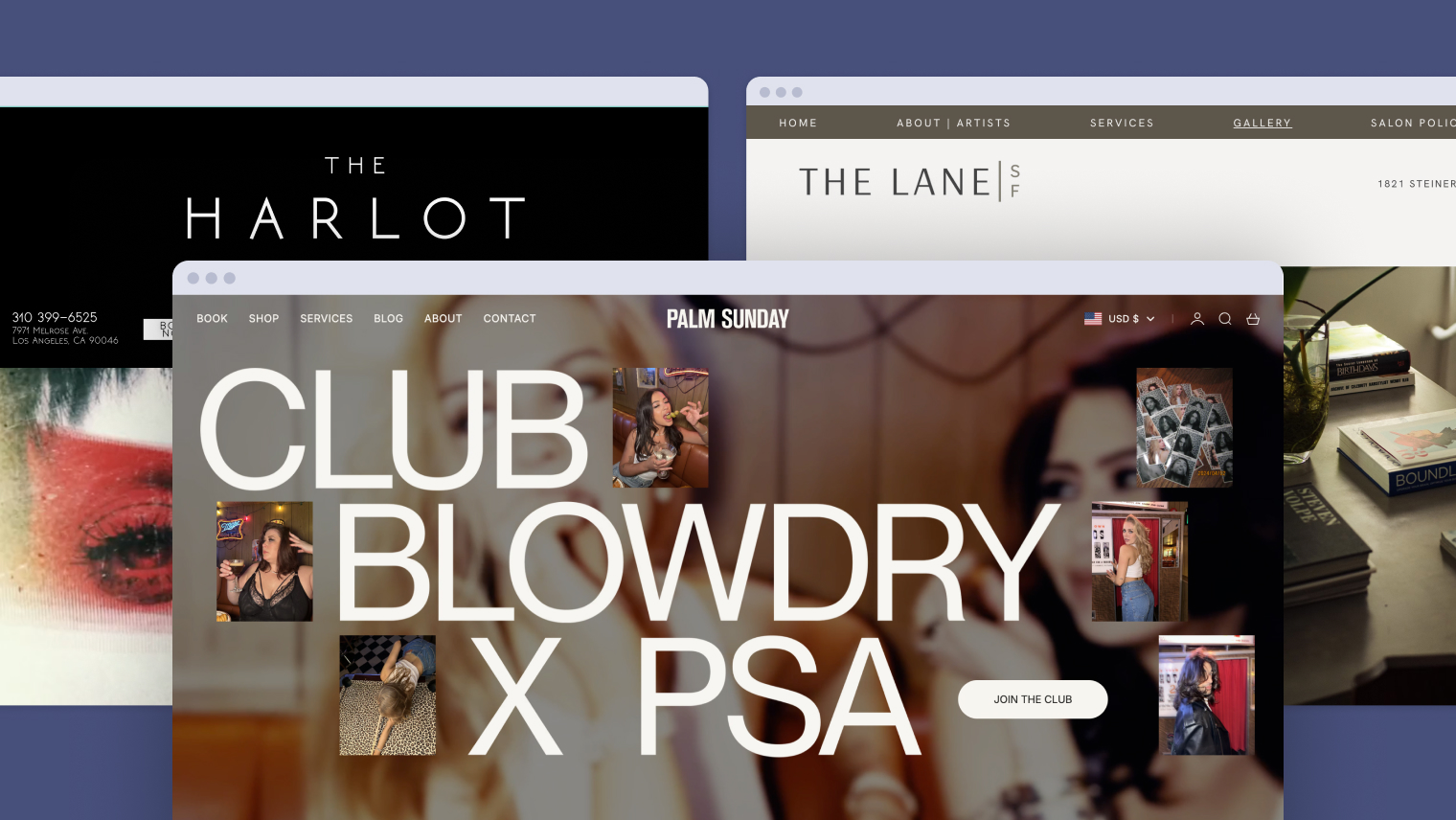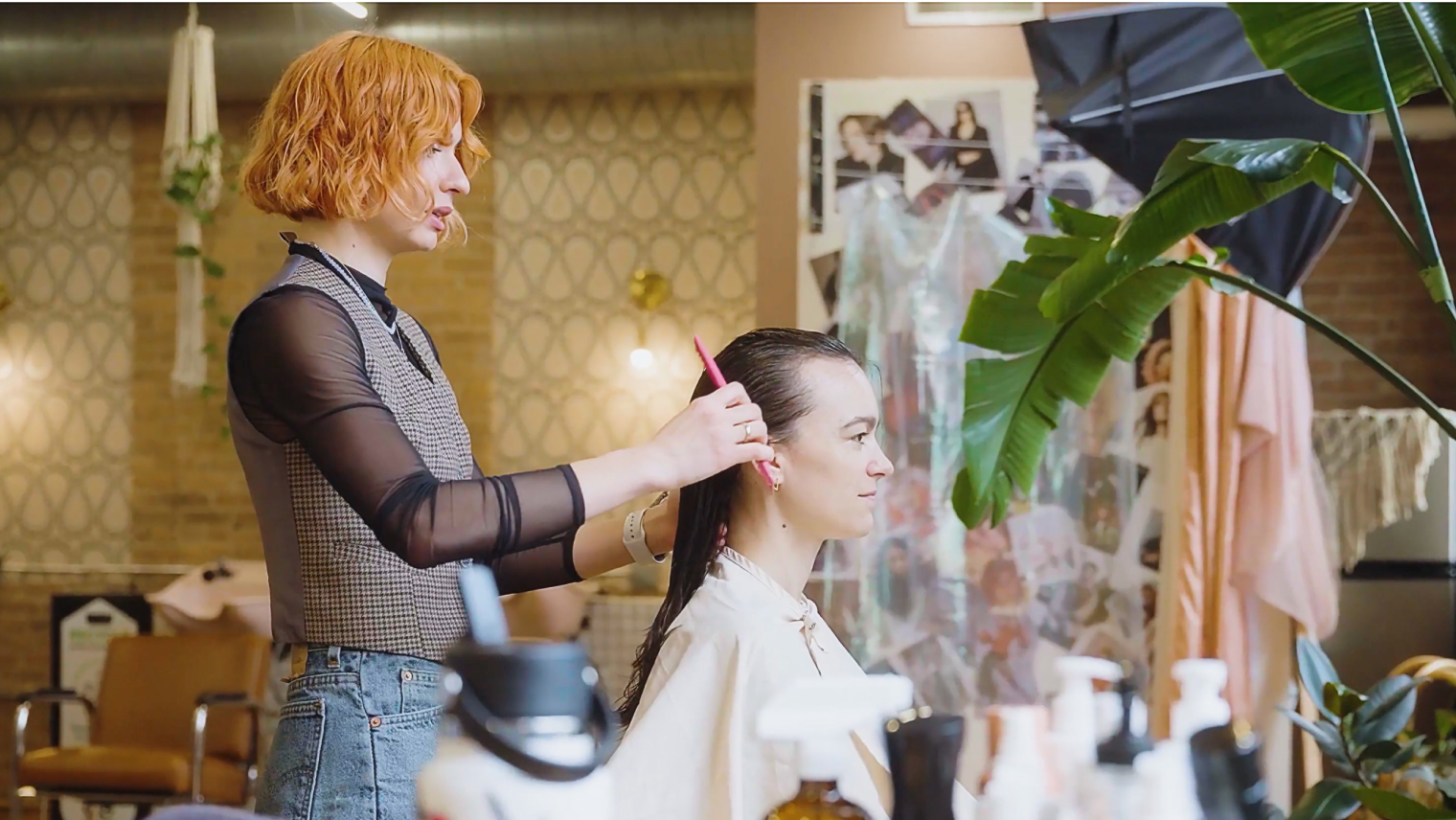
Booth Rent vs Commission: The truth about spa and salon commission structures
We surveyed salon and spa professionals to find out how they utilize commission and booth rental models to get paid.
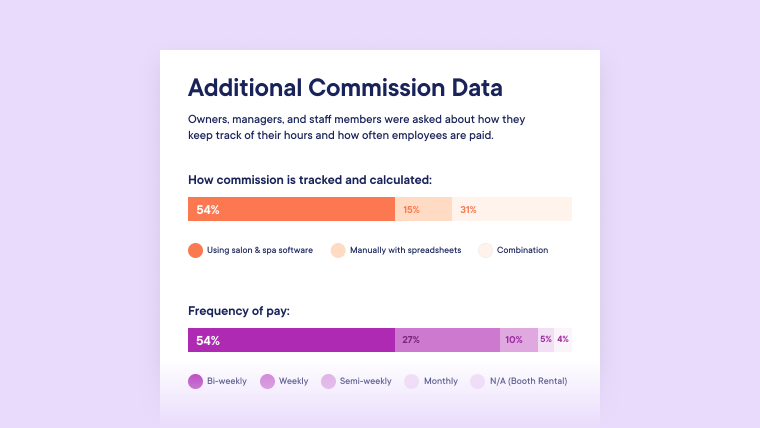
Content Marketing Manager
About the Spa and Salon Compensation Survey
In an effort to provide beauty and wellness professionals with valuable insights about current industry trends on compensation, we conducted our own comprehensive beauty and wellness compensation study.
We surveyed hundreds of owners, managers, and staff across the United States and Canada to determine the most common compensation models, how payments and tips are handled, which commission structures are the most popular, and much more.
This results below show the results of this survey in regard to spa and salon booth rental vs commission compensation structures.
This article addresses statistics pertaining to retail commission, sliding scale commission, commission rates, deductions taken from commission, commission tracking, and frequency of pay, as well as how booth rent is determined, how it is collected, and how often it is collected.
For more information on salon and spa industry compensation, check out the the Salon and Spa Compensation Survey and Hourly vs. Salary Payroll data.
Spa and Salon Commission Structure
Commission is the most commonly used form of compensation in the beauty & wellness industry.

Seventy-five percent (75%) of owners & managers reported that they use commission as a form of compensation for their staff
Forty-two percent (42%) of staff reported that commission is the primary way that they are compensated
Retail Commission
The majority of respondents that identified as owners or managers of a business reported that they offer commission on retail sales made by their employees.
Ninety-three percent (93%) of spa and salon owners and managers pay retail commission
Sliding Scale Commission
Sliding scale commission is payment to staff as various percentages of their sales within set tiers.
For example, an employer may pay a service provider 40% commission (also known as a 40/60 commission split) on all sales from $0 to $3,000 within a given time period and 45% (also known as 45/55 commission split) on all sales from $3,000 to $6,000. Sliding scale commission is generally used to motivate and incentivize staff to increase their sales.
Thirty-three percent (33%) of spa and salon owners and managers use sliding scale commission
Spa and Salon Commission Rates
Spa and salon owners, managers, and staff members reported their commission rates with the majority saying they pay or are paid rates between 40 to 59 percent.
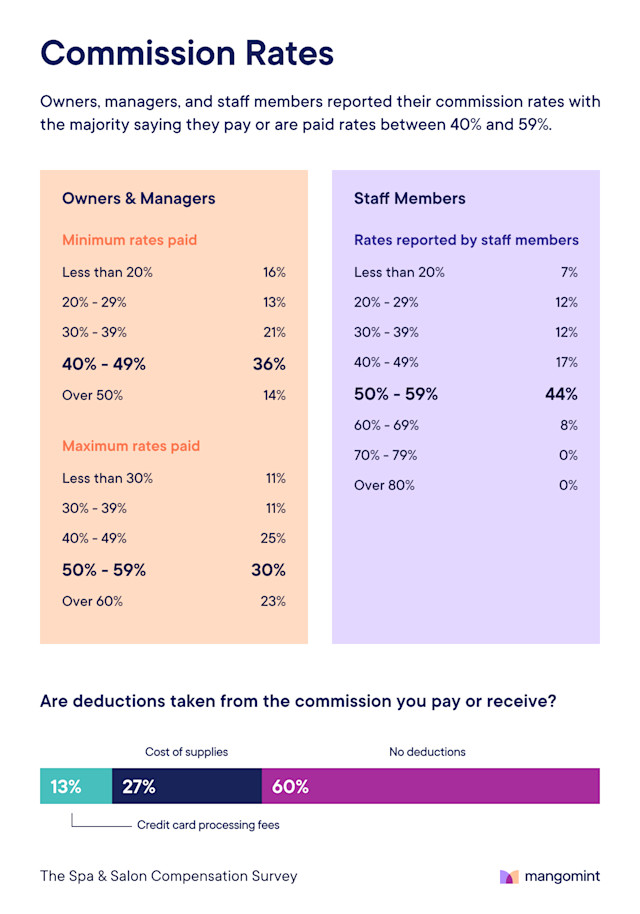
Owners & Managers
Minimum Commission Rates Paid
Sixteen percent (16%) of owners and managers reported that they pay a minimum commission rate of less than twenty percent (<20%)
Thirteen percent (13%) of owners and managers reported that they pay a minimum commission rate between twenty percent and twenty-nine percent (20%-29%)
Twenty-one percent (21%) of owners and managers reported that they pay a minimum commission rate between thirty percent and thirty-nine percent (30%-39%)
Thirty-six percent (36%) of owners and managers reported that they pay a minimum commission rate between forty percent and forty-nine percent (40%-49%)
Fourteen percent (14%) of owners and managers reported that they pay a minimum commission rate over fifty percent (>50%)
Maximum Commission Rates Paid
Eleven percent (11%) of owners and managers reported that they pay a maximum commission rate of less than thirty percent (<30%)
Eleven percent (11%) of owners and managers reported that they pay a maximum commission rate between thirty percent and thirty-nine percent (30%-39%)
Twenty-five percent (25%) of owners and managers reported that they pay a maximum commission rate between forty percent and forty-nine percent (40%-49%)
Thirty percent (30%) of owners and managers reported that they pay a maximum commission rate between fifty percent and fifty-nine percent (50%-59%)
Twenty-three percent (23%) of owners and managers reported that they pay a maximum commission rate over sixty percent (>60%)
Staff Members
Rates Reported by Staff Members
Seven percent (7%) of staff members reported that they receive a commission rate of less than twenty percent (<20%)
Twelve percent (12%) of staff members reported that they receive a commission rate between twenty percent and twenty-nine percent (20%-29%)
Twelve percent (12%) of staff members reported that they receive a commission rate between thirty percent and thirty-nine percent (30%-39%)
Seventeen percent (17%) of staff members reported that they receive a commission rate between forty percent and forty-nine percent (40%-49%)
Forty-four percent (44%) of staff members reported that they receive a commission rate between fifty percent and fifty-nine percent (50%-59%)
Eight percent (8%) of staff members reported that they receive a commission rate between sixty percent and sixty-nine percent (60%-69%)
Zero percent (0%) of staff members reported that they receive a commission rate over seventy percent (>70%)
How Common is a 60/40 Commission Split Salon or Spa?
While a 60/40 commission split salon or spa seems to be the most desired commission structure for many beauty and wellness professionals, only eight percent (8%) of staff members report receiving a commission rate of over fifty-nine percent and only twenty-three percent of business owners and managers report paying staff a maximum commission rate over sixty percent (>60%).
Commission Deductions
Owners, managers, and staff were asked if deductions are taken from the commission they pay or receive.
Thirteen percent (13%) of respondents reported that deductions are taken from the commission they pay or receive for credit card processing fees
Twenty-seven percent (27%) of respondents reported that deductions are taken from the commission they pay or receive for cost of supplies
Sixty percent (60%) of respondents reported that no deductions are taken from the commission they pay or receive
Additional Commission Data
Owners, managers, and staff members were asked about how they keep track of their hours and how often employees are paid.
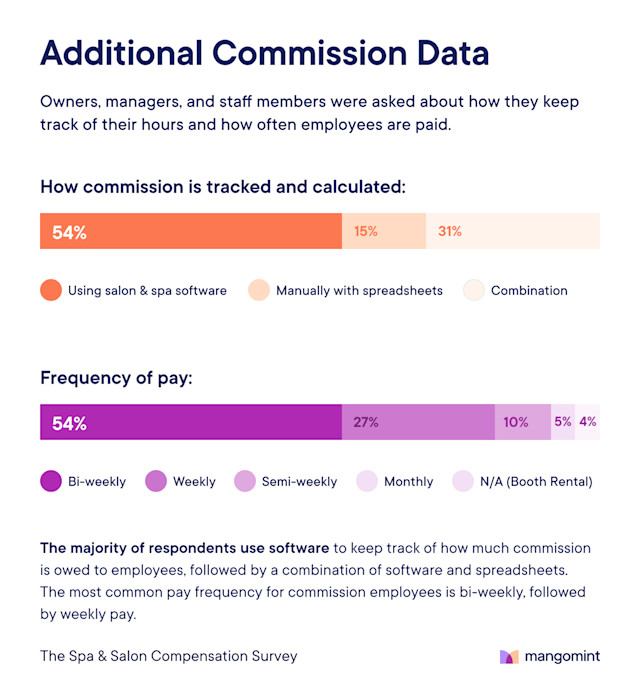
The majority of respondents use software to keep track of how much commission is owed to staff members, followed by a combination of software and spreadsheets. The most common pay frequency for commission employees is bi-weekly, followed by weekly pay.
Commission Tracking
Fifty-four percent (54%) of respondents reported that they track commission with salon and spa software
Fifteen percent (15%) of respondents reported that they track commission with manually using spreadsheets
Thirty-one percent (31%) of respondents reported that they track commission with a combination of salon and spa software and manual spreadsheets
Frequency of Pay
Fifty-four percent (54%) of respondents reported that pay or are paid via commission bi-weekly
Twenty-seven percent (27%) of respondents reported that pay or are paid via commission weekly
Ten percent (10%) of respondents reported that pay or are paid via commission semi-monthly
Five percent (5%) of respondents reported that pay or are paid via commission monthly
Spa and Salon Booth Rental / Suite Rental Structure
Booth rental / suite rental was the least common form of compensation reported by those that participated in the survey.

How Booth Rent Amount is Determined
How rent amounts are determined, according to owners & managers:
Seventy-four percent (74%) of respondents reported that booth rent is owed based on a standard flat amount
Seventeen percent (17%) of respondents reported that booth rent is owed based on a percentage of sales
Nine percent (9%) of respondents reported that booth rent is owed based on a combination of standard flat amount and a percentage of sales
Booth Rent Payment Collection
Participants were asked who collects payments from clients:
Twenty-two percent (22%) of respondents reported that payments are collected by renters
Forty-eight percent (48%) of respondents reported that payments are collected by the business
Thirty percent (30%) of respondents reported that payments are collected by a combination of renters and the business
Rent Payment Frequency
Participants were asked how often rent payments are collected
Seventeen percent (17%) of respondents reported that rent payments are collected weekly
Fifty-eight percent (58%) of respondents reported that rent payments are collected monthly
Twenty-five percent (25%) of respondents reported that rent payments are collected on a different interval
Try Mangomint for free
See Mangomint in action instantly with pre-populated sample data. No credit card required. Free for 21 days.
Try it now
